In the world of digital marketing, capturing audience attention and navigating them further down the path of the buyer’s journey is paramount.
One of the best ways to do this is with ad sequencingA marketing strategy that uses a series of ads in a specific order to create a cohesive narrative and guide customers through their journey..
You’ll create a want for a product by offering a logical sequence of ads to make a potential customer aware, consider, and convert.
This article dives into the four essential steps you need to master during the consideration phase to make the most of ad sequencing.
- Understanding Ad Sequencing in Google Ads
- Step 1: Setting Clear Objectives for Your Ad Sequence
- Step 2: Crafting a Compelling Narrative for Each Ad
- Step 3: Implementing Targeted Audience Segmentation
- Step 4: Monitoring and Optimizing Your Ad Sequence Performance
- Mastering Ad Sequencing for the Consideration Phase
- Frequently Asked Questions on Ad Sequencing
Understanding Ad Sequencing in Google Ads
Ad sequencing is more than just the mere fact of running a set of ads; it tells a story to resonate with your audience.
This strategy relies on a number of ads displayed in order to reinforce your message and establish trust among audiences, thus influencing decision-making.
Particularly, ad sequencing at the consideration phase makes it possible to target users who are already aware of your brand and are evaluating their options.
But how does ad sequencing really work?
At its core, it’s about creating a cohesive journey where each ad complements the previous one.
This progression engages the audience, providing value at every touchpoint and subtly leading them toward a decision.
With Google Ads, the platform’s advanced targeting and scheduling tools make implementing ad sequencing easier than ever.

Illustration of ad sequencing with interconnected icons and arrows, emphasizing the importance of a strategic approach in digital marketing.
Definition and Importance of Ad Sequencing
Ad sequencing is a strategic approach where marketers serve multiple ads to the same audience in a predetermined order.
This works particularly well during the consideration phase, when potential customers are comparing products or services.
By designing a sequence that builds on your previous message, you have better chances of staying top-of-mind and addressing concerns.
- Consistency: Ensures your message aligns with the customer’s journey.
- Engagement: Keeps your audience interested with fresh, relevant content.
- Reinforcement: Strengthens brand recall and trust due to repeated exposure.
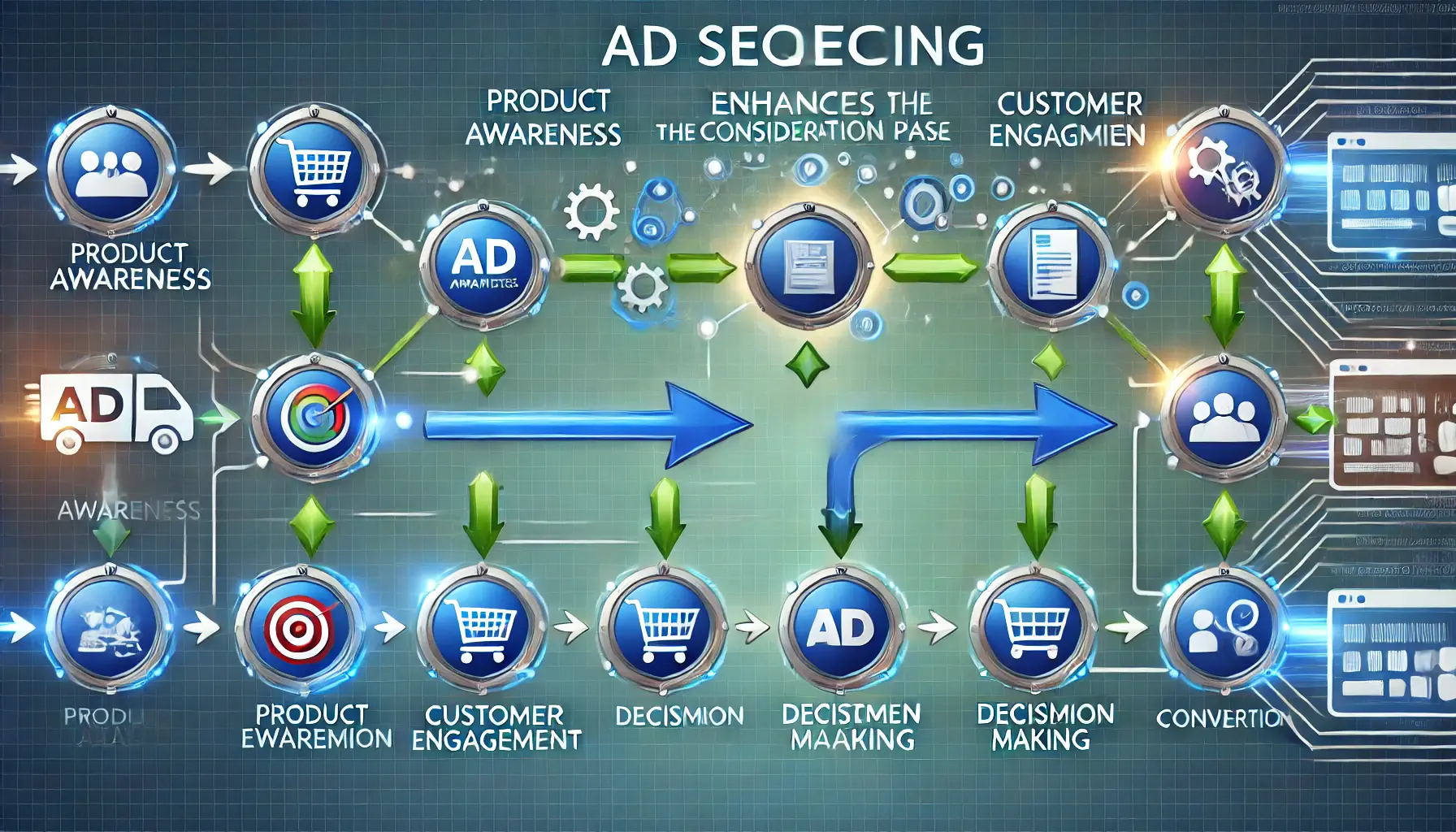
Illustration of how ad sequencing enhances the consideration phase, guiding the audience through the buyer’s journey with connected ad steps.
How Ad Sequencing Enhances the Consideration Phase
The consideration phase is where a potential customer takes more initiative toward their options.
This is where ad sequencing thrives by delivering personalized, persuasive messages at the right time.
A well-planned sequence also helps address common objections, showcase unique selling points, and ultimately build credibility.
- Retargeting: Engage users who have interacted with your brand but have not yet converted.
- Storytelling: Craft a story that resonates with the needs and desires of your target audience.
- Call-to-Action (CTA): Introduce CTAs in steps, relevant to the decision-making stage.

Illustration of the core elements of an ad sequence, emphasizing the key components of relevance, timing, and creativity in digital marketing.
Core Elements of an Effective Ad Sequence
A successful ad sequence is much more than combining a few ads.
Each step should have a purpose and build on the last.
Focus on the following key elements:
- Relevance: Ensure each ad directly addresses the pain points of your target audience.
- Timing: Schedule your ads strategically to align with the user’s journey.
- Creativity: Use visuals and messaging that command attention and evoke emotion.
By grasping these fundamentals, you lay the foundation for an ad sequencing strategy that works effectively in the consideration phase.
Ad sequencing enhances customer engagement by creating a logical flow of ads, building trust, and driving conversions effectively.

Illustration of setting clear objectives for an ad sequence, highlighting the process of defining goals and planning strategy in digital marketing.
Step 1: Setting Clear Objectives for Your Ad Sequence
Embarking on an ad sequencing campaign without clear objectives is like setting sail without a compass.
To effectively guide your audience through the consideration phase, it’s essential to define precise goals that align with your overall marketing strategy.
This clarity ensures that each ad in the sequence serves a specific purpose, leading potential customers closer to conversion.

Illustration of the process of identifying target audience segments and aligning them with marketing goals in digital marketing.
Identifying Target Audience and Goals
Start your work by clearly identifying who your ideal customers are.
This may involve demographic data, interests, behaviors, and purchase history.
Knowing your audience inside and out helps you craft messages that truly speak to the particular needs and preferences of your target audience.
- Demographics: Age, gender, income level, education.
- Interests: Hobbies, activities, topics they engage with online.
- Behaviors: Past purchase history, website interactions, engagement with previous ads.
Once you have defined your target audience, set clear objectives for your ad sequencing campaign.
Do you want to create brand awareness, drive traffic to the website, generate leads, or increase sales?
These defined objectives will subsequently shape the content and structure of the ad sequence.
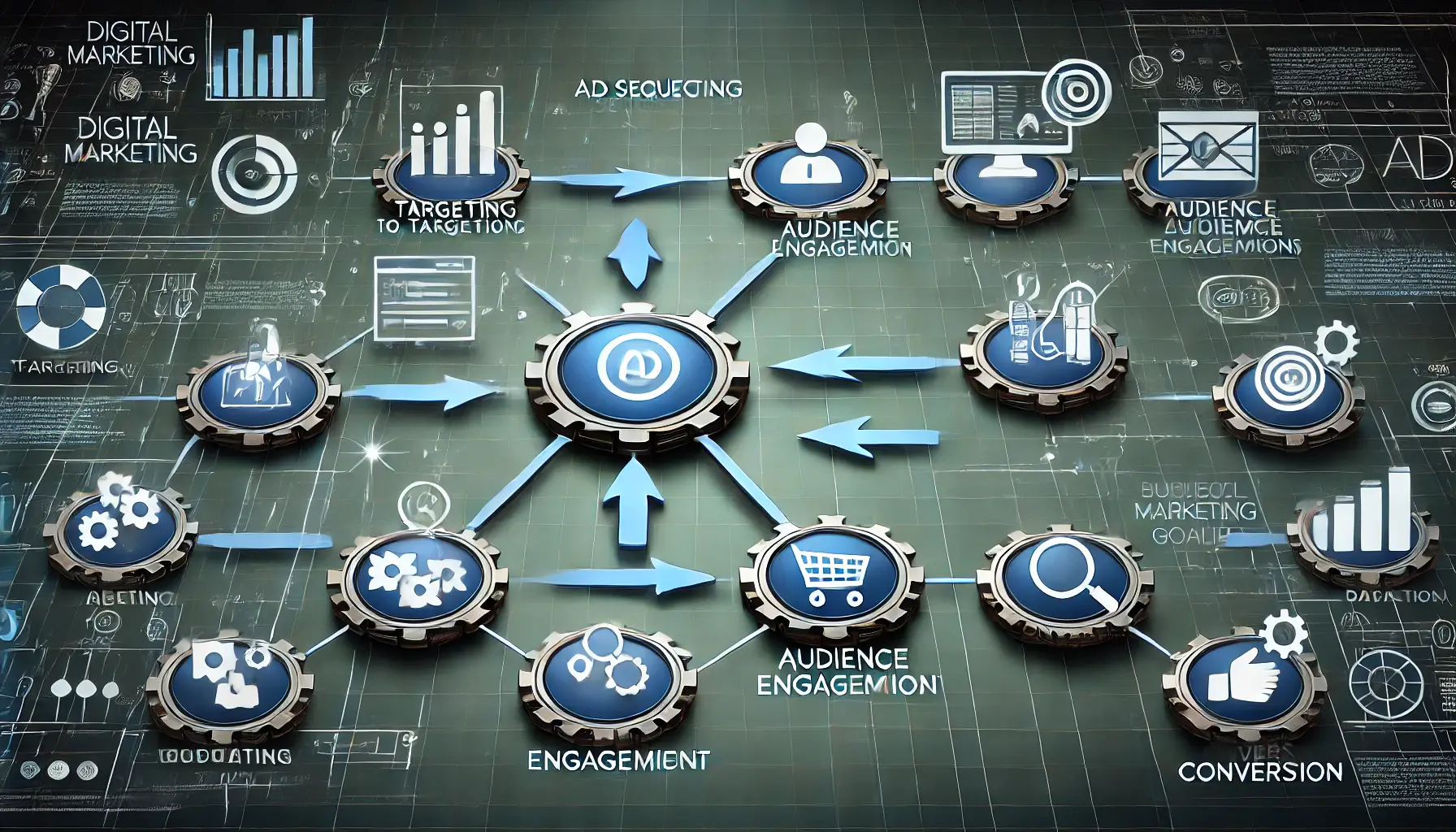
Illustration of the process of setting up ad sequencing, showing how each ad step aligns with marketing goals in a digital marketing strategy.
Setting Up Ad Sequencing to Meet Marketing Objectives
Ad sequencing, put simply, needs to fit well within the overall marketing objectives.
For example, if your objective is brand awareness, your ad sequence might start with an engaging video that introduces someone to your brand, while other ads could follow up with key products or services.
Driving sales might involve ad sequences focused on the benefits of the product, customer testimonials, and limited-time offers.
Consistency across all marketing channels is crucial.
Your ad sequencing efforts should complement other campaigns, such as email marketing, social media outreach, and content marketing, to create a unified brand message.

Illustration of measuring success in digital marketing, with icons representing KPIs like conversion rate, click-through rate, and return on ad spend.
Measuring Success: KPIs and Metrics
To evaluate the effectiveness of your ad sequencing campaign, establish key performance indicators (KPIsKey Performance Indicators; metrics used to measure the success of a campaign or strategy.) that align with your objectives.
Common KPIs include:
- Click-Through Rate (CTR): The percentage of viewers of your ad who clicked on it.
- Conversion Rate: The percentage of people who viewed your ad and took a desired action, such as purchasing something or submitting a form.
- Cost Per Conversion: The amount spent on average for one conversion to be accomplished.
- Return on Ad Spend (ROAS): The revenue generated for each dollar spent running the advertisements.
Regularly track these metrics against performance, using them to make informed, data-driven adjustments to optimize your ad sequencing strategy.
This iterative process allows for continuous improvement and maximizes the return on your advertising investment.
Defining clear objectives ensures that each ad in your sequence serves a specific purpose, guiding potential customers toward conversion.

Illustration of crafting a compelling narrative for digital ads, showing the connection between creative storytelling and audience engagement.
Step 2: Crafting a Compelling Narrative for Each Ad
In the realm of ad sequencing, storytelling is a powerful tool that can captivate your audience and guide them through the consideration phase.
By crafting a compelling narrative for each ad, you create a cohesive journey that resonates with potential customers, addressing their needs and building a connection that leads to conversion.

Illustration of how to develop engaging storylines for ads, showcasing key elements like characters, emotions, and audience engagement.
Developing Engaging Storylines
To develop engaging storylines, start by understanding your audience’s pain points and desires.
Create characters or scenarios that mirror their experiences, making your ads relatable and authentic.
Each ad should serve as a chapter in your brand’s story, gradually revealing more information and value.
- Identify Key Messages: Determine the core messages you want to convey in each ad.
- Structure the Sequence: Plan the order of ads to build anticipation and maintain interest.
- Maintain Consistency: Ensure that the tone, style, and messaging are consistent across all ads.

Illustration of how visual and emotional appeals in ads can engage audiences by using vibrant visuals and emotional triggers.
Using Visual and Emotional Appeals
Visual materials and emotional resonance are powerful ways of making your ads memorable.
Leverage high-quality visuals that complement the character of your brand and resonate with target emotions.
Whether it’s joy, trust, or excitement, tapping into an emotional space could make all the difference in audience engagement.
- Visual Consistency: Use consistent color schemes, fonts, and imagery to strengthen brand recognition.
- Emotional Triggers: Add storytelling that elicits emotions relevant to your target audience.
- Call-to-Action (CTA): Design visually noticeable and emotionally compelling CTAs.

Illustration of how different ad formats maintain consistency in messaging, design, and branding across platforms.
Consistency Between Different Ad Formats
Ad sequencing requires maintaining consistency in the execution of ad formats, be it video, display ads, or social media.
This helps reiterate your brand message and provides a seamless experience for the audience.
- Unified Messaging: Keep the core message consistent with appropriate adaptability across various formats.
- Brand Elements: Apply consistent logos, taglines, and brand colors to all ads.
- Adaptation for Platforms: Fit the ads according to the format and best practices of each platform while maintaining the overall narrative.
By focusing on these aspects, you can create an engaging ad sequencing narrative that fosters audience engagement, builds trust, and guides them through the consideration phase to conversion.
Engaging storytelling can create emotional connections and enhance audience engagement, making your ad sequence memorable and effective.
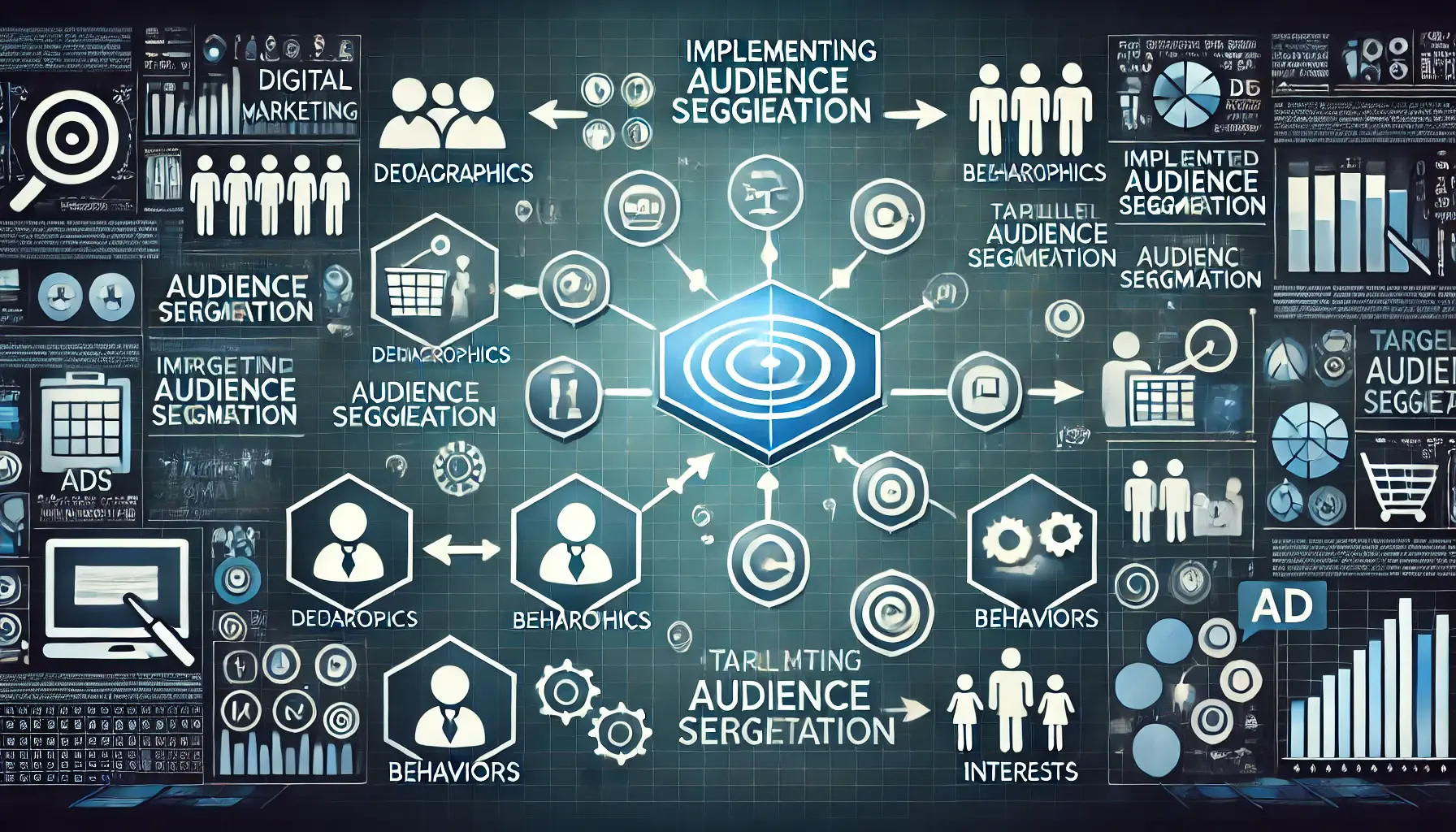
Illustration of implementing targeted audience segmentation, showing how different audience segments are divided and connected to tailored ads.
Step 3: Implementing Targeted Audience Segmentation
Effective ad sequencing hinges on delivering the right message to the right audience at the right time.
To achieve this, implementing targeted audience segmentation is crucial.
By dividing your audience into distinct groups based on specific criteria, you can tailor your ad sequences to resonate with each segment, enhancing engagement and driving conversions.

Illustration of audience segmentation, showing how distinct segments such as demographics, interests, and behaviors relate to targeted ads.
Understanding Audience Segmentation
Audience segmentation is the division of your potential customers into groups that share similar qualities.
It assists in personalizing your marketing to ensure that each segment receives content relevant to their interests and needs.
- Demographic Segmentation: Segment based on age, gender, income level, education, and other demographic factors.
- Geographic Segmentation: Divide people by location, such as country, region, or city.
- Psychographic Segmentation: Group audiences based on lifestyle, values, interests, and personality traits.
- Behavioral Segmentation: Categorize users by behavior, including purchase habits, interaction with brands, and product usage.

Illustration of leveraging Google Ads for audience segmentation, showing how different audience groups are targeted with precision.
Leveraging Google Ads for Audience Segmentation
Google Ads facilitates highly effective audience segmentation with its powerful tools, enabling you to develop customized ad sequencing strategies.
- Detailed Demographics: Target users based on advanced demographic information, such as parental status, marital status, and education level.
- Affinity Audiences: Reach users whose interests and habits align with your brand by targeting predefined audience segments.
- In-Market Audiences: Engage users who are actively researching or comparing products and services like yours.
- Custom Segments: Create unique audience segments using a combination of criteria such as keywords, website visits, and app usage.
- Remarketing Audiences: Re-engage users who have previously visited or used your website or app, encouraging them to continue their journey.
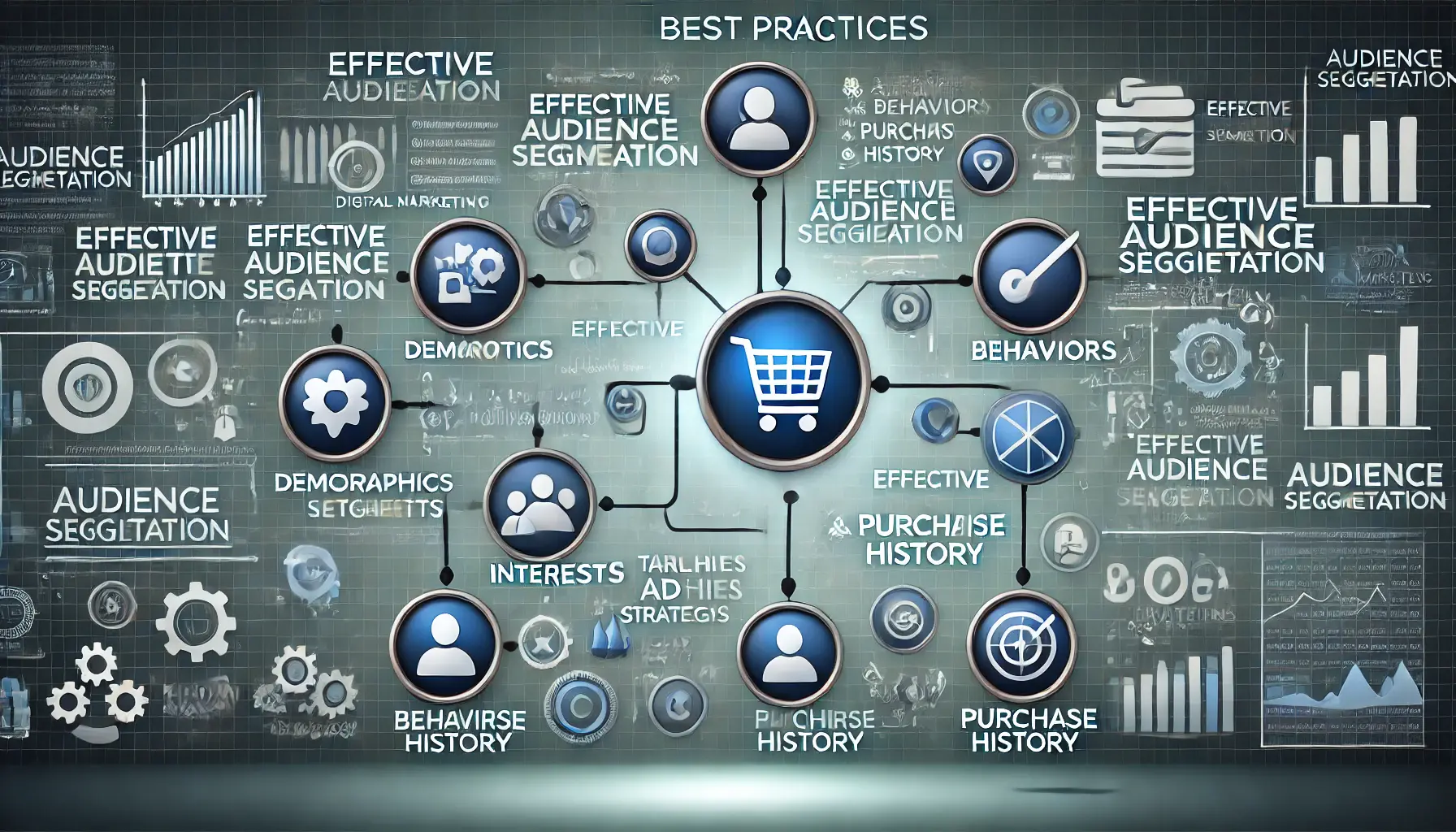
Illustration of best practices for effective audience segmentation, emphasizing personalization and relevance for tailored ad strategies.
Best Practices for Effective Audience Segmentation
To maximize the impact of your ad sequencing via audience segmentation, consider the following best practices:
- Data-Driven Decisions: Use analytics and insights to create an informed segmentation strategy that ensures accuracy and relevance.
- Continuous Refinement: Regularly reevaluate and refine your segments based on performance metrics and evolving audience behaviors.
- Personalized Messaging: Develop ad content that speaks directly to the specific needs and preferences of each segment.
- Consistent Branding: Maintain a cohesive brand voice and visual identity across all segments to build trust and recognition.
By applying targeted audience segmentation, you can optimize your ad sequencing campaigns, delivering personalized experiences that resonate with your audience and drive meaningful results.
- Behavioral segmentation helps craft ads that resonate with specific audience actions and preferences.
- Demographic and geographic insights further refine your message.

Illustration of monitoring and optimizing ad sequence performance, showing metrics, analysis, and optimization tools working together.
Step 4: Monitoring and Optimizing Your Ad Sequence Performance
Implementing an ad sequencing strategy is just the beginning.
To ensure its effectiveness, continuous monitoring and optimization are essential.
By analyzing performance metrics and making data-driven adjustments, you can enhance engagement, improve conversion rates, and maximize your return on investment.
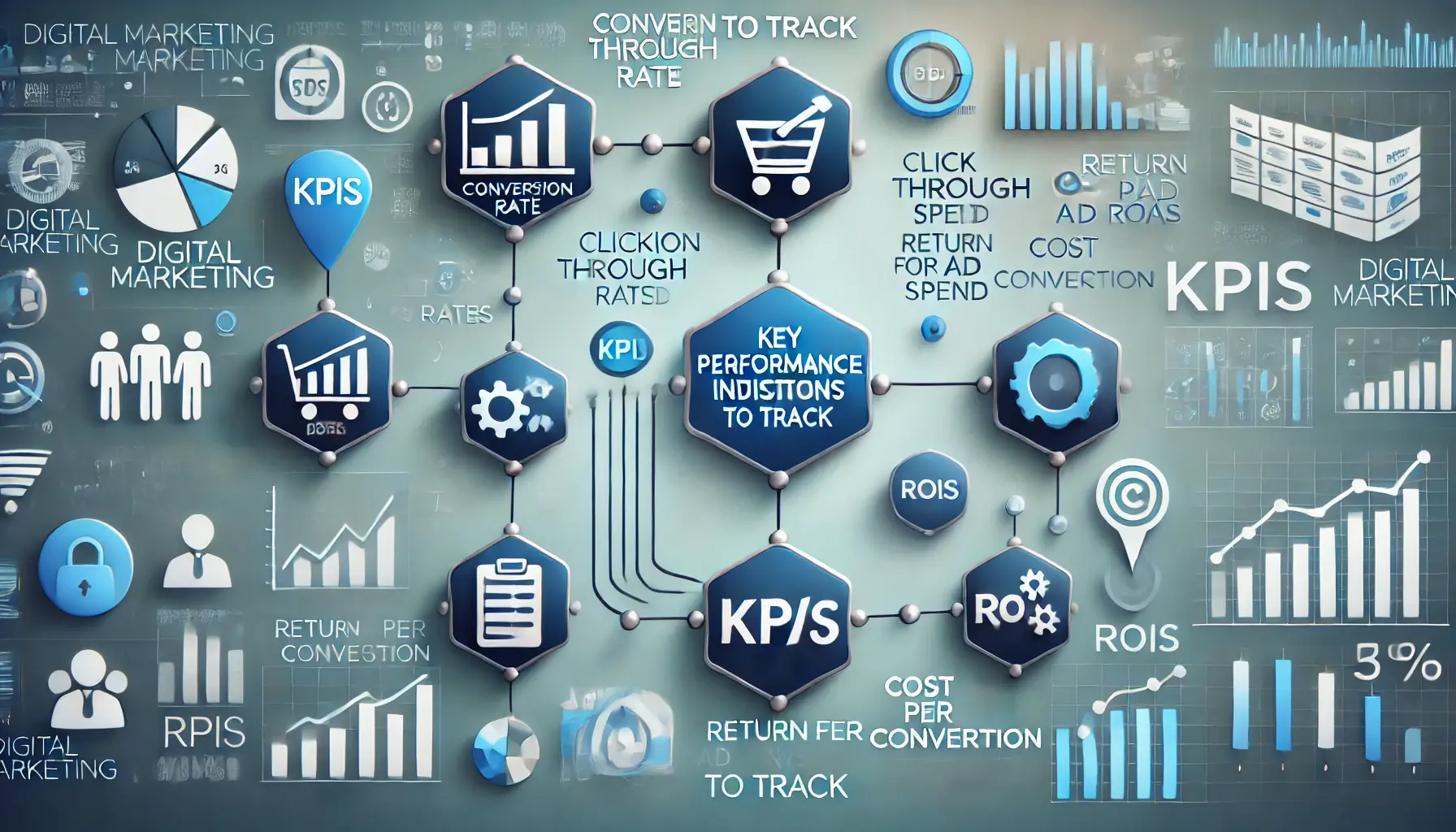
Illustration of KPIs to track in digital marketing, showing various metrics like conversion rates, click-through rates, and ROAS.
Key Performance Indicators (KPIs) to Track
Monitoring specific KPIs will show how your ad sequences are performing.
Here are the metrics to keep in view:
- Click-Through Rate (CTR): The percentage of viewers that clicked on your ad, showing its appeal and relevance.
- Conversion Rate: The number of users who took the desired action after encountering your ad sequence, such as purchasing a product or submitting a form.
- Cost Per Conversion: The average amount spent to achieve a single conversion, helping assess the efficiency of your ad spend.
- Return on Ad Spend (ROAS): The revenue generated for each dollar spent on advertising, reflecting the overall profitability of your campaigns.

Illustration of utilizing A/B testing for optimization, showing two versions of an ad tested against each other with arrows and data visuals.
Utilizing A/B Testing for Optimization
A/B testing, or split testing, refers to running two different versions of an ad or sequence to see which performs better.
It’s a great way to test different elements to find out what works best with your audience.
Key components include:
- Test Variables: Experiment with elements like headlines, images, calls-to-action, and the sequencing order.
- Control and Variation: Maintain a control group with the original ad sequence and a variation group with the modified element.
- Analyze Results: Compare performance metrics between the two groups to identify significant differences and implement the more effective version.

Illustration of leveraging analytics tools, showing interconnected icons like graphs and dashboards working together to analyze marketing data.
Leveraging Analytics Tools
Utilize analytics platforms to gain deeper insights into your ad sequence performance.
Tools like Google Analytics and Google Ads provide comprehensive data to inform your optimization efforts.
- Audience Behavior: Understand how users interact with your ads and navigate through your sequences.
- Attribution Analysis: Determine which ads or sequences contribute most to conversions, allowing for better resource allocation.
- Real-Time Monitoring: Access up-to-date performance data to make timely adjustments and capitalize on emerging trends.

Illustration of continuous improvement in digital marketing, showing iterative processes with gears, arrows, and graphs.
Continuous Improvement Through Iteration
Optimization is an ongoing process.
Regularly review your ad sequencing strategy and make iterative changes based on performance data.
- Feedback Loops: Establish mechanisms to gather feedback from your audience and incorporate it into your strategy.
- Stay Updated: Keep your knowledge current about the latest industry trends and evolving consumer behaviors, shaping your sequences accordingly.
- Scalability: If certain ad sequences work effectively, scale them up to larger audiences or across more channels.
By carefully monitoring and optimizing your ad sequencing efforts, you will develop more effective campaigns aligned with the needs of your audience, driving meaningful results.
Optimization through A/B testingA method of comparing two versions of an ad or campaign to determine which performs better. and KPI tracking ensures continuous improvement and maximizes ad sequencing ROI.
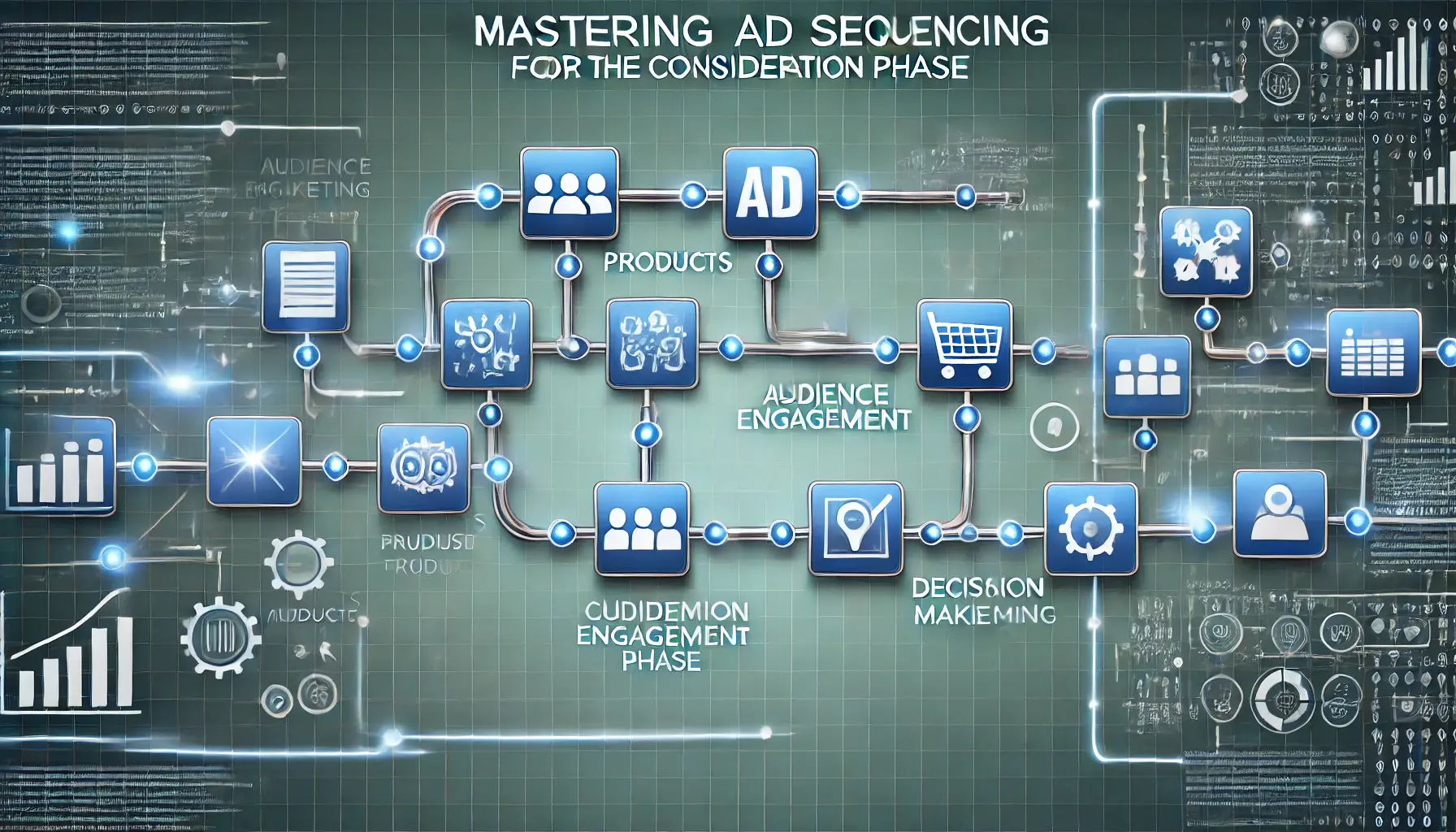
Illustration of mastering ad sequencing in the consideration phase, guiding customers through their journey with connected ad elements.
Mastering Ad Sequencing for the Consideration Phase
Ad sequencing is a transformative approach in digital marketing, designed to guide your audience seamlessly through the buyer’s journey.
By breaking down the process into structured steps, businesses can ensure their campaigns are both strategic and impactful.
Let’s recap the critical components that make ad sequencing a game-changer during the consideration phase.

Illustration of the key takeaways from the four steps of ad sequencing, showing the connection between goal setting, crafting, segmentation, and optimization.
Key Takeaways from the Four Steps
Each step of ad sequencing contributes to an integrated strategy that gradually guides potential customers through a series of actions toward conversion.
Highlights include the following:
- Setting Clear Objectives: Define your goals and identify your target audience. This lays the foundational perspective necessary for ad sequences that reflect your overall marketing strategy.
- Crafting Compelling Narratives: Tell a story in your ads to make them engaging, relatable, and emotionally resonant for your audience.
- Implementing Audience Segmentation: Divide your audience into distinct segments based on demographics, behaviors, and interests to deliver personalized messages.
- Monitoring and Optimization: Regularly track performance metrics, conduct A/B testing, and utilize analytics tools to refine and enhance your ad sequencing strategy.

Illustration of the power of personalization and consistency in digital marketing, showing the connection between customized experiences and maintaining brand identity.
The Power of Personalization and Consistency
The true strength of ad sequencing lies in its ability to provide a personalized and consistent experience for your audience.
By understanding their needs and preferences, you can deliver ads that are both relevant and timely, fostering trust and engagement.
Consistency across platforms and formats reinforces your brand identity, ensuring that your message resonates at every touchpoint.

Illustration of maximizing results through data-driven insights, showing how data analysis tools help optimize ad performance.
Maximizing Results Through Data-Driven Insights
Data is at the heart of effective ad sequencing.
By leveraging insights from performance metrics and audience behavior, you can make informed decisions that drive meaningful results.
This data-driven approach allows for continuous improvement, ensuring that your campaigns remain dynamic and adaptable in a fast-paced digital landscape.
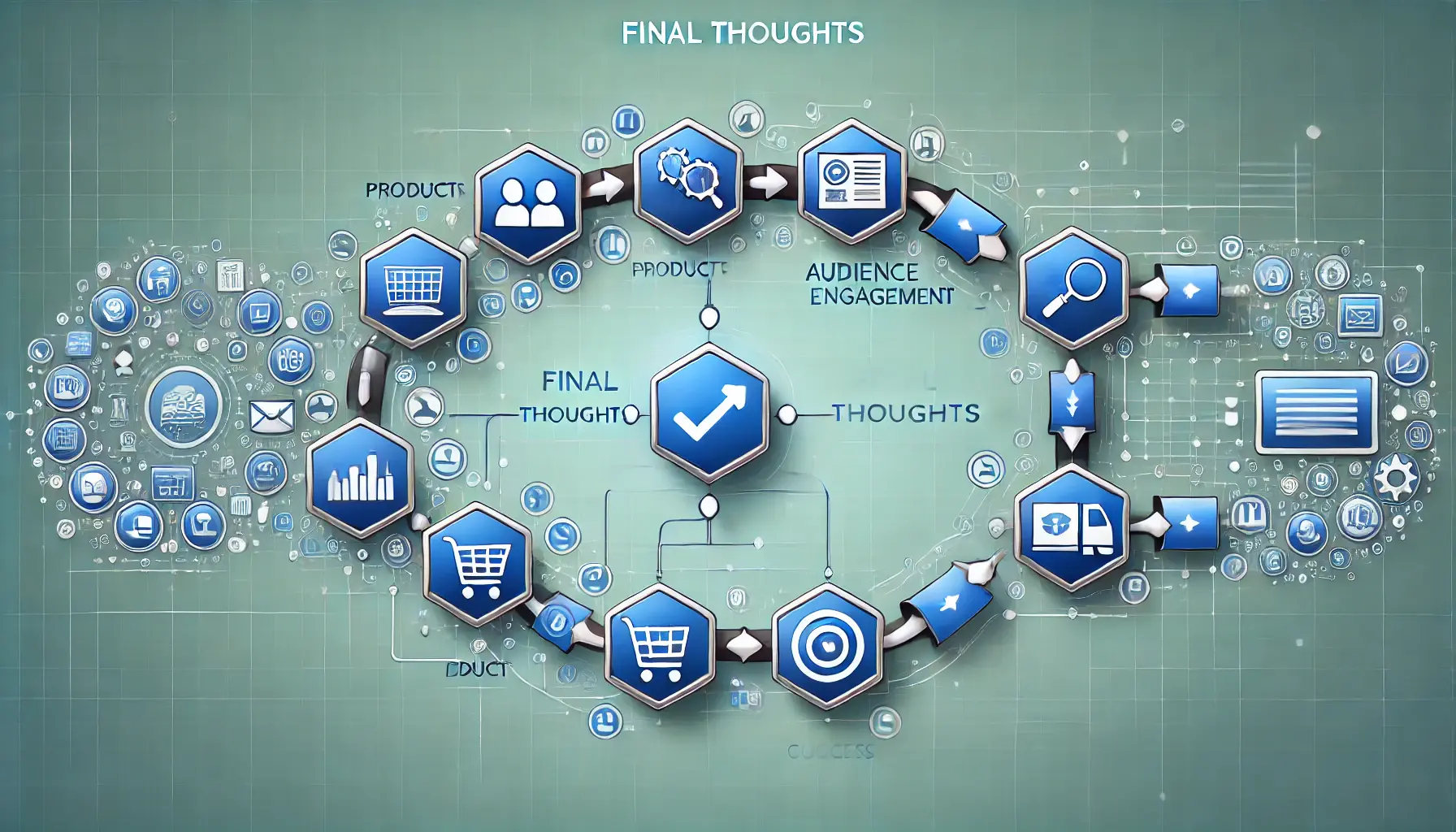
Illustration of the final thoughts on ad sequencing, showing a completed sequence guiding users from engagement to conversion.
Final Thoughts on Ad Sequencing
Ad sequencing isn’t just a marketing tactic; it’s a comprehensive strategy in which storytelling, personalization, and analytics align to create impactful campaigns.
By following the four steps outlined in this article, you can apply ad sequencing to its full potential, capturing your audience’s attention and guiding them toward conversions.
Whether you’re building brand awareness or encouraging final purchase decisions, ad sequencing is an indispensable tool for success in the consideration phase.
Ad sequencing combines storytelling, personalization, and data-driven insights to guide potential customers through the buyer’s journey effectively.
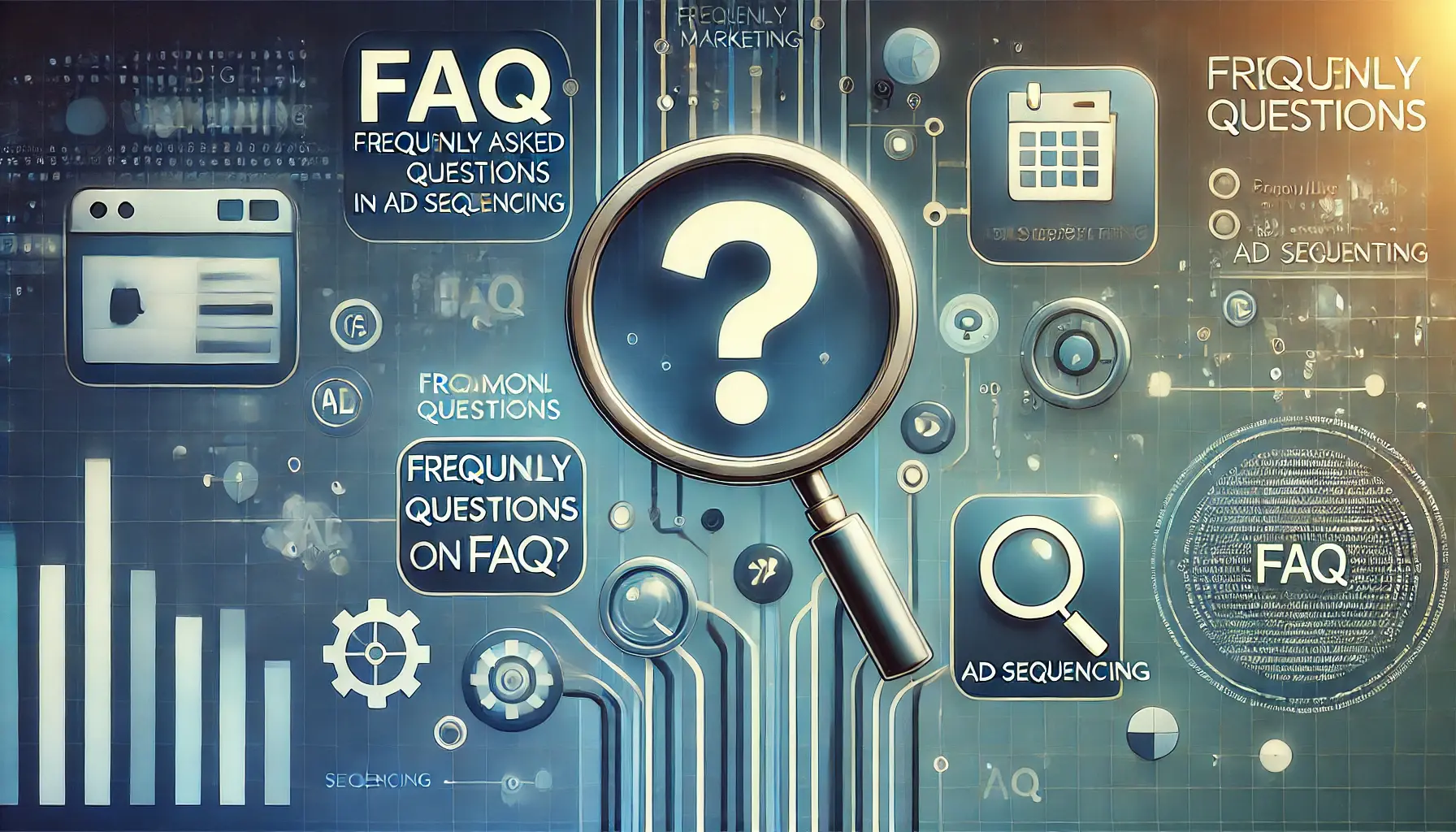
Illustration of frequently asked questions on ad sequencing, showing the process of inquiry and finding solutions in ad strategies.
Your campaigns can be managed by an agency specialized in Google Ads, check out our service page.
Frequently Asked Questions on Ad Sequencing
Ad sequencing is a pivotal strategy in digital marketing.
Below are common questions to help you understand its nuances.
Ad sequencing is a strategy where multiple ads are shown to the same audience in a specific order to tell a cohesive brand story.
It guides potential customers through a structured narrative, reinforcing key messages and addressing objections, leading to informed purchasing decisions.
Define specific goals aligned with your marketing strategy, such as increasing brand awareness, driving website traffic, or boosting conversions.
Storytelling creates an emotional connection, making ads more engaging and memorable, which enhances audience engagement and brand recall.
Use criteria like demographics, interests, behaviors, and purchase history to create distinct groups for targeted messaging.
Key metrics include Click-Through Rate (CTR), Conversion Rate, Cost Per Conversion, and Return on Ad Spend (ROASReturn on Ad Spend; a metric used to measure the revenue generated for each dollar spent on advertising.).
A/B testing allows you to compare different ad elements to determine which performs better, facilitating data-driven optimizations.
Yes, ad sequencing can be implemented across various platforms, including Google Ads, YouTube, and social media channels.
Regularly monitor performance data and adjust your strategy as needed to ensure continuous improvement and effectiveness.











